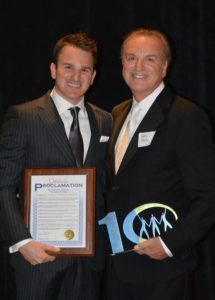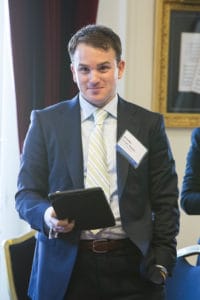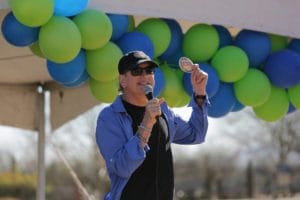
ULI Foundation governor Bob Sharpe is president of Sharpe & Associates and the founder of Rancho Sahuarita, a 3,000-acre master-planned community of nearly 6,000 homes outside Tucson, Arizona. Rancho Sahuarita is considered by industry experts to be among the most successful communities of its type in the United States, offering middle-class families spacious homes, high-quality schools, and safe neighborhoods filled with parks, trails, and resort-style amenities—all at an affordable price point. Sharpe has been a ULI member since 1994 and has held several leadership positions within the Institute, including trustee, member of the Fall/Spring Meeting Program Committee, chair of the Community Development Council (CDC) product council (Green Flight), Terwilliger Center board member, and ULI Arizona advisory board member. He is currently a member of the CDC (Green Flight) and a council counselor.
Bob’s son, Jeremy, followed his father into the family business and serves as vice president of community development at the Rancho Sahuarita Company. Jeremy grew up attending ULI meetings with his father and has been an active member since 2007. He was named a member of Urban Land magazine’s 40 Under 40 class of 2016, is a founding member of ULI NEXT, has served on the Fall/Spring Meeting Program Committee, and recently became a ULI Foundation governor. Giving Back spoke with Bob and Jeremy Sharpe about the role ULI has played in their lives and in Bob’s recent recovery from glioblastoma, an aggressive form of brain cancer.
Giving Back: Welcome, Bob and Jeremy. Bob, you were diagnosed with brain cancer in March 2015. After surgery, your doctors said you had a 2 percent chance of surviving. Yet, here you are today, cancer-free and living life to the fullest. How has that experience shaped your outlook?

Bob: I’ve been told that you never truly beat brain cancer, and that you’re essentially waiting for another tumor to come back. Waiting for “the other shoe to drop” can be stressful, but only if I allow myself to waste the precious time that I may have left by worrying and postponing doing the things that make me happy today. Regardless of the time remaining in my life, I am moving forward with the attitude that what will be, will be. I am appreciating every moment of every day as a miracle.
Jeremy: My family has been very fortunate. With any type of brain surgery, you can never know the possible adverse outcomes. In my dad’s case, the surgery amplified his positive traits. All my life, my dad was the one taking care of others and making people feel good about themselves. Since his surgery, he has become even more positive and seeks to remind people that “today is a good day,” no matter what is happening in their life—which reflects the mission of our company: to create a better life for others.
Giving Back: Bob, I understand that “Today Is a Good Day” has become your life philosophy and the name of a foundation you’ve started. Can you talk more about what has become your life’s passion—to help others afflicted with brain cancer and support research toward finding a cure?
Bob: Every day after my surgery, Jeremy would call me and ask, “How are you feeling today?” No matter what had happened that day, I would always say, “Today is a good day.” Jeremy surprised me on my one-year survival anniversary with 1,000 “Today Is a Good Day” stickers, and over the past year I have handed out over 3,000 stickers to people. Since my surgery, I have devoted my life to helping others afflicted by cancer but [who] don’t have my resources or connections with the goal of having something good come out of my own struggle with brain cancer.
I have partnered with the National Brain Tumor Society [NBTS] to move cancer research forward in a big way. Through various fundraisers we have raised about $550,000, and my goal for the end of the year is to get to $600,000. Many of my ULI friends helped me raise that money. With those funds, we have set up the Sharpe-NBTS Brain Cancer Research Awards, which is a minimum of $25,000 award for each of the top ten cancer research institutions in the United States for immunotherapy research. The remaining money will support an awards program for 2018 where we will offer a $100,000 first-place award for the best idea to cure brain cancer [$50,000 second place; $25,000 third place]. The institutions that received the initial $25,000 will be eligible to compete for the 2018 award.
Giving Back: Both of you are highly involved ULI members. Can each of you talk about what ULI has meant to you, professionally and personally?

Jeremy: When my dad got sick, I had the daunting task of informing our company, family, and friends. I called 60 of my dad’s ULI friends, and I can’t tell you how many people said, “What do you need? What can we do to help?” That experience exemplified what ULI has meant to our family. In our darkest of times, those ULI friends were there. In the first three of months of my dad’s treatment—when he was undergoing radiation and his initial chemotherapy—those conversations made all the difference in guiding me through not just a difficult time personally, but also through the business challenge of keeping the company moving forward in the right direction. The biggest support was that people just listened. They let me vent as I expressed my anger, frustration, and sadness at times.
Professionally, ULI has provided me with incredible learning experiences. My dad drilled into us the importance of learning and asking questions, and ULI was the perfect forum to soak everything up. Through different service opportunities that I’ve had with ULI, I’ve developed invaluable relationships with people I consider to be mentors and friends.
Bob: ULI has been a family affair since I became a member nearly 25 years ago. I would bring Jeremy to meetings when he was a teenager. Until my diagnosis in 2015, I had never missed a Fall or Spring Meeting! My goal has always been to give back to ULI as much as I’ve gotten out of ULI. I initially got involved with ULI because I bought 3,000 acres of land and had a vision of creating a town and a better place for people to live. But at 32 years old, I didn’t know anything about development! People were so generous with me at ULI. They invited me to their projects and answered my questions as they shared their own mistakes made and lessons learned. I took the best ideas from around the country and implemented them in ways that would be appropriate for southern Arizona.
Giving Back: Bob, Rancho Sahuarita will be a big part of your legacy. You took barren, desert land and turned it into a thriving community with more than 17,000 residents. Do you feel your vision for Rancho Sahuarita has been realized?

Bob: Our guiding principle has always been: how do you provide amenities that improve people’s lives without adding to the cost? For me, it has never been about the money but about our mission and vision of creating a great lifestyle for people and families at a price they can afford. Remarkably, we have built a financially sustainable land development company by staying true to our mission. It’s Jeremy’s turn now to make Rancho Sahuarita his own and continue the work that we have started.
Jeremy: Since the beginning, we’ve had an incredible team. It all comes down to our people, who have adopted our mission of creating a better life for our residents. We try to continually improve on what we’re doing. We started out with a few events per month; now we host over 150 events per year. During the recession, everyone was struggling, including many of our residents whose homes were underwater. Rather than taking away services, we provided even more value for them. We provided free and affordable babysitting and we have taken the health and wellness of our residents to the next level by not only offering a system of parks and trails, a gym, and fitness classes, but also adding a nutritionist and chef on site to teach families how to make healthy meals.
Bob: Rancho Sahuarita lives well and provides value, and values, for its residents. That’s my legacy, but I think you’ll find that the project speaks for itself.



